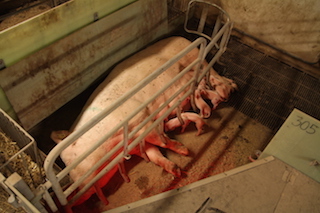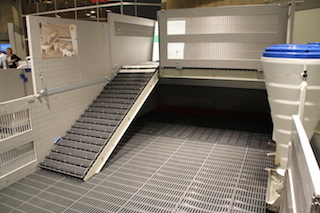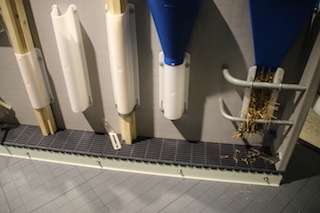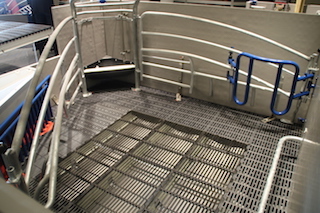Denmark only has a population of five million people but as far as pigs are concerned she punches well above her weight, with pig exports both live and dead contributing substantially to the Danish economy and balance of payments.
So to see new developments, Denmark is the place to be at!
The 65th European Association of Animal Production was held last August in Copenhagen and a considerable number of research papers related to the lactating sow. The results will eventually filter through and be used to boost production at farm level.

Several of the researchers that attended the EAPP event were speakers at an International Pig Seminar which was a curtain raiser to Agromek 2014, billed as Northern Europe’s largest agricultural fair. The seminar was organized by the Danish Pig Research Centre (VSP), which is tasked with carrying out research and passing the results on to Danish producers. The Pig Research Centre (which also owns DanAvl, the breeding stock organization) is financed by producer levy and employs 166 staff, many of whom carry out on trials on 200 commercial units across Denmark.
Martin Andersson is Head of Department at VSP. Speaking at the seminar, he commented that the industry has structural problems, with low investment in finisher barns, whilst a new start breeding unit must have 1500 sows, in order to be profitable. Units are getting bigger and producers are decreasing.
In 2005 there were 8886 producers – 10 years later these numbers have more than halved, to 3500. With finisher pigs, in 2013 the average slaughter weight stood at 82.7 kg (with an average lean meat percentage of 60.2,) which according to Andersson is 10 kg too low for most profitable production, but the processors don’t want heavier carcasses. DanAvl breeders produce the Yorkshire/ Landrace F1, for crossing with the Duroc – no synthetics here. DanAvl is still breeding for bigger litters. Mortality is a problem with hyper prolific genotypes and so DanAvl include LP 5 in their breeding index. (It actually comprises 27 per cent of the index).This is the piglet mortality at day five post farrowing and is a measure of mothering ability. LP5 is still going down, which is a good thing as last March politicians commented that the Danish public were concerned about piglet mortality and that pre-weaning losses have to be reduced. Other aspects of the breeding programmes involve reducing aggressiveness (at farrowing), the genetics of boar taint and breeding resistance against E.coli. Lifetime performance – this wants raising to four to six parities.
English producers used to complain that the English government “gold plated” that is topped up EU legislation, plus of course the English government unilaterally banned gestation stalls back in 1999, (way before the rest of Europe had to comply –in 2013). “Gold plating” might now be levelled at Danish legislators, as from Jan 1, 2015 in new facilities, sows must be group housed from service and in all existing houses by Jan 1, 2035.
“Gestation units must have straw bedding and water sprinklers – more Danish -specific legislation,” commented VSP Quality Manager Asger Kjaer Nielsen.” The government is also keen on free farrowing, proposing that 10 per cent of sows farrow free by 2020 (pens are grant aided) and that any new farrowing facilities built after 2021 must not have crates. (One per cent in ). The aim is to install, with government funding, 16,000 free farrowing pens over the next two years. From July 1, 2015, no fully slatted floors will be allowed, in any type of shed. Weaners are allowed to be 50 per cent slatted, with finishers at 33 per cent. As far as toys are concerned, chains are not allowed.
Thomas Bruun and Sonke Moller told the audience how the Danes get 35 pigs / sow / year. Correct feeding during pregnancy & lactation is vital. Farrowing house management has to be top drawer plus using the nurse / foster sow techniques s key management aid. This involves using about 10 per cent of lactating sows. A sow that is milking well (Nurse sow one) with a big litter is weaned at three weeks and she is given a litter from a sow that’s been farrowed 10 days (Nurse sow two). Surplus newborn piglets (more than 12 hours old) are then fostered on to Nurse sow two. This technique keeps surplus piglets alive but pushes up the cost of expensive farrowing accommodation by 10 per cent.
The Agromek fair is held every two years in Herning, and has a livestock and machinery focus. The fair is selling itself as north Europe’s largest farming expo and looks to attract visitors from Russia and the Baltic countries as well, of course, from Denmark’s Scandinavian neighbours. The organizers were delighted that they attracted more exhibitors than in 2012, plus attendees were greater as well (46,919 vs 45,248). As at EuroTier, many of the equipment companies had free farrowing pens on display. This concept is fine for sow welfare, but what about piglet welfare, at risk from being overlaid by a lazy mum? In addition, the freedom pens are much larger than conventional farrowing crated pens which has  caused implications.
caused implications.
Pen design allows the stockperson to feed the sow / check the trough from outside the pen, but there are health and safely implications when it comes to handling piglets with an anxious mother in very close proximity. One of the problems with hyper prolific sows is that often the sow has morepiglets than teats with weaning weights suffering as a consequence. German Feed company Broring GmbH were displaying their Culina cup system. The cups are fitted in the creep area and provide supplemental milk (containing special additives to prevent digestive upsets) for piglets which can’t get enough from their mum. As the piglets get older a liquid pre-starter is introduced which helps the gut adjust to higher dry matter feed. Continuing with welfare, a number of companies were exhibiting toys, designed to keep pigs out of mischief.
Chains are banned in Denmark and a popular alternative is a solid plastic tube fixed just above floor level, to the pen division, containing wood which pigs can chew on.
Having been over 40 years in the industry I now see concepts coming round a second time! Many of the free farrowing pens come in this category. Another one is twin level weaner housing, with pens being fitted with a mezzanine floor, accessed by a narrow walkway connecting the two levels. This concept, which was being promoted by Ikadan A/S, allows denser stocking but having pigs dunging and urinating on their neighbours below might not be thought acceptable in some quarters.
Niels Aage Arve owns a 1200 sow unit which has 300 free farrowing and SWAP (Sow Welfare and Piglet Protection) pens. The SWAP pens restrain the sows for 48 hours after which she can roam around freely. His farm is to all intents and purposes a trials unit for these free systems and he gets funding from VSP to cover his extra staff etc. The pre-weaning mortality, at 18 per cent, is too high and Niels wants it down to 15 per cent.
“To make the free farrowing system commercially viable I need a premium for my pigs, but this is not yet being paid,” complained Niels.
Welfare is very high on the Danish pig industry agenda but it costs money Danish producers must receive a premium to cover the extra costs of these welfare implications and if they are not forthcoming, then what? The Danish government is maybe hoping that the EU will adopt these practices right across all of Europe and get all the EU to convert to high welfare pig production. This might be satisfactory for inter EU trading, but pig meat is a worldwide traded commodity and EU pig producers will certainly not want to be disadvantaged relative to the rest of the world. •
— By Norman Crabtree





